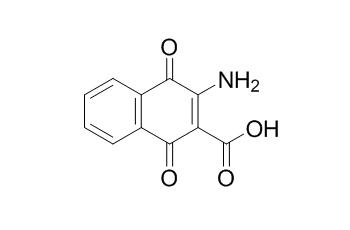2-Amino-3-carboxy-1,4-naphthoquinone
2-Amino-3-carboxy-1,4-naphthoquinone is a novel growth stimulator for bifidobacteria, it affects the end-product profile of bifidobacteria through the mediated oxidation of NAD(P)H.
Inquire / Order:
manager@chemfaces.com
Technical Inquiries:
service@chemfaces.com
Tel:
+86-27-84237783
Fax:
+86-27-84254680
Address:
1 Building, No. 83, CheCheng Rd., Wuhan Economic and Technological Development Zone, Wuhan, Hubei 430056, PRC
Providing storage is as stated on the product vial and the vial is kept tightly sealed, the product can be stored for up to
24 months(2-8C).
Wherever possible, you should prepare and use solutions on the same day. However, if you need to make up stock solutions in advance, we recommend that you store the solution as aliquots in tightly sealed vials at -20C. Generally, these will be useable for up to two weeks. Before use, and prior to opening the vial we recommend that you allow your product to equilibrate to room temperature for at least 1 hour.
Need more advice on solubility, usage and handling? Please email to: service@chemfaces.com
The packaging of the product may have turned upside down during transportation, resulting in the natural compounds adhering to the neck or cap of the vial. take the vial out of its packaging and gently shake to let the compounds fall to the bottom of the vial. for liquid products, centrifuge at 200-500 RPM to gather the liquid at the bottom of the vial. try to avoid loss or contamination during handling.
Journal of Medicinal Food2023, Vol.26(10).
Dent Mater J.2020, 39(4):690-695
Plants (Basel).2020, 9(11):1555.
Mol Neurobiol.2023, 60(12):7196-7207.
Biomolecules.2020, 10(6):925.
J Breast Cancer.2015, 18(2):112-118
Phytomedicine.2021, 83:153483.
Adv Healthc Mater.2024, 13(13):e2303276.
ACS Synth Biol.2022, doi: 10.1021.
The Japan Society for Analytical Chemistry2018, 67(4):201-206
Related and Featured Products
Biochim Biophys Acta. 1999 Aug 5;1428(2-3):241-50.
Role of 2-amino-3-carboxy-1,4-naphthoquinone, a strong growth stimulator for bifidobacteria, as an electron transfer mediator for NAD(P)(+) regeneration in Bifidobacterium longum.[Pubmed:
10434042]
2-Amino-3-carboxy-1,4-naphthoquinone (ACNQ) is a novel growth stimulator for bifidobacteria. The role of ACNQ as a mediator of the electron transfer from NAD(P)H to dioxygen (O(2)) and hydrogen peroxide (H(2)O(2)), proposed in our previous paper, was examined using the cell-free extract and whole cells of Bifidobacterium longum.
METHODS AND RESULTS:
Continuous monitoring of ACNQ, O(2) and H(2)O(2) by several amperometric techniques has revealed that ACNQ works as a good electron acceptor of NAD(P)H diaphorase and that the reduced form of ACNQ is easily autoxidized and also acts as a better electron donor of NAD(P)H peroxidase than NAD(P)H. The generation of H(2)O(2) by B. longum under aerobic conditions is effectively suppressed in the presence of ACNQ. These ACNQ-mediated reactions would play roles as NAD(P)(+)-regeneration processes.
The accumulation of ACNQ in the cytosol has been also suggested.
These characteristics of ACNQ seem to be responsible for the growth stimulation of bifidobacteria.
CONCLUSIONS:
Vitamin K(3), which has an extremely low growth-stimulating activity and was used as a reference compound, exhibits much lower activity as an electron transfer mediator. The difference in the activity is discussed in terms of the redox potential and partition property of the quinones.
Appl Microbiol Biotechnol. 2002 Jun;59(1):72-8.
2-Amino-3-carboxy-1,4-naphthoquinone affects the end-product profile of bifidobacteria through the mediated oxidation of NAD(P)H.[Pubmed:
12073135 ]
Glucose metabolism of bifidobacteria in the presence of 2-Amino-3-carboxy-1,4-naphthoquinone (ACNQ), a specific growth stimulator for bifidobacteria, and ferricyanide (Fe(CN)(6)(3-)) as an extracellular electron acceptor was examined using resting cells of Bifidobacterium longum and Bifidobacterium breve.
METHODS AND RESULTS:
NAD(P)H in the cells is oxidized by ACNQ with the aid of diaphorase activity, and reduced ACNQ donates the electron to Fe(CN)(6)(3-). Exogenous oxidation of NADH by the ACNQ/Fe(CN)(6)(3-) system suppresses the endogenous lactate dehydrogenase reaction competitively, which results in the remarkable generation of pyruvate and a decrease in lactate production. In addition, a decrease in acetate generation is also observed in the presence of ACNQ and Fe(CN)(6)(3-). This phenomenon could not be explained in terms of the fructose-6-phosphate phosphoketolase pathway, but suggests rather that glucose is partially metabolized via the hexose monophosphate pathway. This was verified by NADP(+)-induced reduction of Fe(CN)(6)(3-) in cell-free extracts in the presence of ACNQ. Effects of the ACNQ/Fe(CN)(6)(3-) system on anaerobically harvested cells were also examined.
CONCLUSIONS:
Stoichiometric analysis of the metabolites from the pyruvate-formate lyase pathway suggests that exogenous oxidation of NADH is an efficient method to produce ATP in this pathway.



